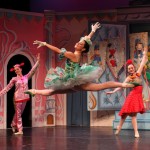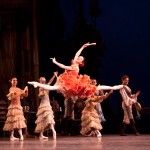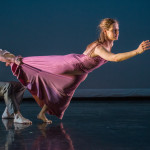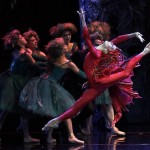
Zhong-Jing Fang (centre) as the benevolent Sugar Plum Fairy in Alexei Ratmansky’s new version of The Nutcracker for American Ballet Theatre, which premiered last Christmas to great acclaim at the Brooklyn Academy of Music. Photo: Gene Schiavone.
Another Christmas brings us “one more Nutcracker closer to death,” grumbled English dance critic Richard Buckle. Although it is a German story infused with Russian Christmas traditions, nowhere is The Nutcracker more eagerly recreated than in America. Jennifer Dunning writes that The Nutcracker “fits well into the category of made-to-order traditions concocted by a country too young to have many traditions of its own… what unfolds on stage has a great deal in common with the slightly hesitant American ideal of the happy, enduring family of a sort wistfully immortalized in the art of Norman Rockwell.” In this ideal society, the reward for little girls who are sweet and well-behaved, who aren’t afraid of mice, and who possess killer arabesques is a trip to a cotton-candy-filled land where they will meet the handsome prince of their dreams. A land ruled by the Sugar Plum Fairy.
More than the evil Black Swan, the pure but doomed White Swan, the naive Giselle, or spoiled Kitri, to most audiences the Sugar Plum Fairy embodies the ideal ballerina: queenly, gracious and generous, with dazzling but unflashy technique. Exquisite pointework is a hallmark of her variation, as illustrated in Yuri Grigorivich’s version for the Bolshoi.
Despite the countless reinventions of The Nutcracker over the decades, a few things appear not to have changed since the ballet’s premiere in 1892 in St. Petersburg. Critics of that production, choreographed by Lev Ivanov, decried the hordes of children who swarmed the stage normally reserved for the world’s most brilliant technicians. (Ballet to the People sympathizes with those early critics, as she found herself at San Francisco Ballet’s production longing to order a miniature infantry battalion back to their barracks, to make room for more grown-ups on stage. But she is aware of the power wielded by parents of toy soldiers and mice who buy tickets by the bushel.)
The Italian ballerina who danced the first Sugar Plum Fairy, Antonietta Dell’Era, was derided by critics at the time as “corpulent” and “podgy.”
Fast forward to 2010 when New York Times critic Alastair Macaulay took New York City Ballet’s Jenifer Ringer to task for looking “as if she’d eaten one sugar plum too many.”

New York City Ballet’s Jenifer Ringer as the Sugar Plum Fairy. The grumpy New York Times critic who called her overweight may need to have his vision checked.
His complaint is not only preposterous – Jenifer Ringer is a gorgeous and appealing dancer with not an ounce of fat on her – it is also dangerous, because in his role as dance critic, Macaulay has the power to set standards, and the standard he promulgates here is antiquated, unhealthy and artistically irrelevant. His statement panders lazily to the stereotype of ballerinas as frail and undernourished.
Jumping on the same bandwagon is Krissy Keefer, feminist choreographer and creator of the socially conscious, leftist Revolutionary Nutcracker Sweetie, which features a homeless Sugar Plum Fairy, and portrays Clara as an undocumented worker in the home of the McGreed family. Keefer explains in an interview that her choreographic motivation was to depict “strong women dancing. Not ballerinas or skinny modern dancers, but athletic dancers.” She further claims that “so many women wanted to dance but there were no real role models for dancers and social change enthusiasts.”
Sigh. Keefer knows that ballet dancers are extreme athletes, and yet she continues to push this stereotype. No doubt she is also aware that many of the greatest ballerinas from Marie Taglioni in the early 1800’s to Anna Pavlova at the turn of the 20th century and Maria Tallchief in the 1940’s and 50’s, were pioneers who broke out of the confines of social class, gender or ethnicity, who lived by their own rules, and won admiration and respect not simply for their talent but also for their independent spirit, drive and determination. Some, like Taglioni, had bodies that were not ideally suited for ballet and they developed extraordinary muscle power and control to compensate.
Today, Misty Copeland of ABT and Sara Mearns of NYCB are just two examples of the many leading American ballerinas who radiate power and vitality; then there is Natalia Osipova of the Bolshoi, whose phenomenal jumps match those of any partner and whose onstage presence has been likened to “a speeding bullet,” and Alesia Novikova of the Mariinsky who tosses off entrechat quatres en pointe in quick succession the way her male counterparts normally do on flat – all of them, in Keefer’s own words, “strong women dancing.”
Feminist critics of classical ballet choreography have only to watch the fearsome Myrtha and her gang of Wilis send the strapping gamekeeper Hilarion plunging to his death in Act II of Giselle, a scene so terrifying that I think the ballet deserves an “R” rating. In theatre, film and opera there are few portrayals of female strength and superiority as devastating as this.
That said, dancers themselves occasionally perpetuate the fragile artist trope. Gelsey Kirkland, at the height of her battle with drugs and an eating disorder, portrayed Clara with such brittle poignancy that she was almost painful to watch – weak and emaciated, you feared that with every hop en pointe she would shatter a bone. The 1977 film of her dancing with Mikhail Baryshnikov in his version of The Nutcracker for ABT remains hugely popular today, in large part due to Baryshnikov’s exquisite choreography for Clara’s variation, so simple yet compelling. Kirkland’s execution of that variation is fluid and musical, yet the image of this anorexic woman-child is chilling and disturbing.
Baryshnikov is one of several choreographers who chose to do away with the Sugar Plum Fairy altogether, or relegate her to a supporting role, as they give her variation and the pas de deux to Clara and her Nutcracker Prince, portrayed by adult dancers. In these versions, Clara represents the ideal ballerina and it is often poignant to watch her “grow up” from innocent girl to self-assured young woman. The final shot of the ABT film shows Clara looking out of her bedroom window, troubled and wistful. She has woken up from a dream in which she not only got to go on a world tour and taste the best sweets from every nation, but also fall in love with a handsome prince. In this version of the ballet, Clara learns that part of growing up is realizing that dreams do not always come true, and that princes do not always stick around.
San Francisco-based choreographer Mark Foehringer keeps the Sugar Plum Fairy in the picture but adds his own charming and effective twist by having Clara dance behind her, tentatively imitating her steps as the queen of the realm graciously demonstrates them. This reinforces the image of the wise Sugar Plum Fairy as role model and mentor to little girls, and neatly avoids having to cast a grown woman in the role of a young girl.
Jennifer Fisher, in her scholarly and enjoyable book, “Nutcracker” Nation, recollects how performing in a local production of the ballet as a young girl was for her a “seditious activity” and how ballet represented not a frivolous, elitist pastime but a “metaphor for achievement and transcendence.” For so many thousands of young girls who work their way up the Nutcracker ‘ladder’ from mice and Mother Ginger’s children in their first year to toy soldiers then flowers and snowflakes in subsequent years, Nutcracker represents a formal, complex and disciplined rite of passage. A tiny handful of talented girls will get to dance Clara, and this in turn gives them a shot at the ultimate prize: the Sugar Plum Fairy. This is meritocracy at its best: tenure, antecedents, social class, ethnicity, and where you went to school mean nothing in the world of The Nutcracker; all that counts is natural talent and hard work.
As a young woman in the 70’s, Fisher was dismayed to encounter feminist critiques of ballet that accused the art form of objectifying women, just as beauty pageants do, of celebrating the helplessness and fragility of women who require noble princes to support them and steer them around on stage. Pointe shoes came under fire as instruments of torture and oppression – akin to the barbaric practice of foot-binding in ancient China –forcing women into precarious, unstable positions whereas male dancers remain securely flat on the ground and control the ballerinas’ movements.
Most ballerinas, however, find the sensation of rising en pointe exhilarating and liberating. Pointe shoes are highly engineered precision tools that allow us to employ our technique in ways that are impossible in flat slippers. One discovers a new ease in pirouettes, a new power in the action of relevé, new length in the line of the leg, and added drama in the curve of the instep. One feels sorry for men, who don’t get to experience this exhilaration. (One witty ballerina notes that this is a little like feeling sorry for men because they don’t get to experience labor and delivery.)
Skeptics need only attend a partnering class to get an idea of the ballerina’s status vis-à-vis her partner. Classical partnering technique requires that the male dancer learn to feel the ballerina’s centre of balance en pointe – this is a tactile not visual sense. The ballerina steps into her pose and her partner attempts to centre her; when he has gotten her on her balance, the man should feel as if the ballerina’s weight has “disappeared”, that is, there is no pressure on either of his hands. This is the first challenge in partnering. Later on, during lifts, the ballerina simply has to jump and her partner then has to do all the work. Her jump mechanics and timing have to be accurate, but it is his responsibility to get her in the air smoothly and in the right position (and avoid injury). Feminist critiques of ballet generally assume that the man shoves the ballerina around on stage and controls her, whereas he is simply trying like hell to fulfill the terms of his employment.
Enfin, the world of ballet is not egalitarian when it comes to the division of labor between the sexes. Mark Morris strived to correct this imbalance in his version of The Nutcracker, and succeeded beautifully when he put men en pointe alongside women in Waltz of the Snowflakes – his choreography for this scene brings Tchaikovsky’s glorious music to life far better than any other version:
But Morris was a Sugar Plum Fairy-hater, apparently, because he did away with her. Why should we care? Here’s one reason – watch this little girl as she watches a rehearsal of the Sugar Plum Fairy pas de deux. She understands the power and the goodness of the Sugar Plum Fairy.







Oooo I see you got your own domain name! Congratulations!
I love reading your articles– I always learn something new and fascinating, and they’re always well thought out and fun to read. I also love that you always post videos to watch as well. Great stuff! Ms. Kirkland’s video was especially interesting to watch because of her scary thinness. I am very supportive of this “dancers as athletes” movement over the “dancers who need a sandwich” movement. I would much rather my body become lean and muscular as opposed to delicate and thin. I would love to dance and have an audience see the power behind my movements as opposed to worrying that I will snap at any given moment. Yay for strong dance-builds!
Anyway, I miss coming to class! This really rough semester is finally drawing to a close, so I might be able to come to a class once before I’m shuttled off to Atlanta for the holidays.
Hi,
great article – thank you for sharing it with us. I agree with the Alastair Macauley point; he really should have rethought that one. For someone so visible within the arts community to take such a retrograde step regarding the dancing body is just irresponsible. Yes, he’s being paid to give his opinion, but on the dancing, not on how fat or thin a dancer is. I’m sure anyone not operating regularly in the ballet circle would think that it’s just living up to it’s archaic stereotype. Anyhow, this could go on for a while, so I’ll wrap it up there.
Diarmaid
Thank you for writing in, Diarmaid. It’s great to hear from dancers who are not only physically engaged in but also thinking, analyzing and writing about dance.
So many thoughts – where do I begin?!
I get so annoyed when people think ballet isn’t athletic or a “sport”. My response to that is always that we have to do incredibly athletic routines, and then we have to make it look effortless. That, my dear friends, is why you didn’t notice it was a sport. That said, athletes eat food guys. Therefore, so should ballerinas. Any critic calling any of those women fat should be relegated to a diet of kale and celery until s/he recants.
As for the sugar plum fairy – it’s just plain cruel to take her out of the nutcracker! I can’t count how many times I’ve been to the show, and waited anxiously for her to appear. And then I find they’ve written her out? My sad ballerina heart wilts just a little.
Love the little girl at the end too 🙂
Great post. Wonderful overview with historical context. Learned a bit about the early history of the Nutcracker. But most importantly, we’re challenged to rethink strength and ballerina in the classical ballet. This is an art form steeped in stereotype, but not when viewed through the fresh eyes of this blog. We’re also asked to question – to paraphrase Naomi Wolff – the ballet beauty myth. Very sound critical thinking backed by strong examples.
Hi! I’ve been reading your website for a long time now and finally got the bravery to go ahead and give you a shout out from Humble Texas! Just wanted to tell you keep up the fantastic job!